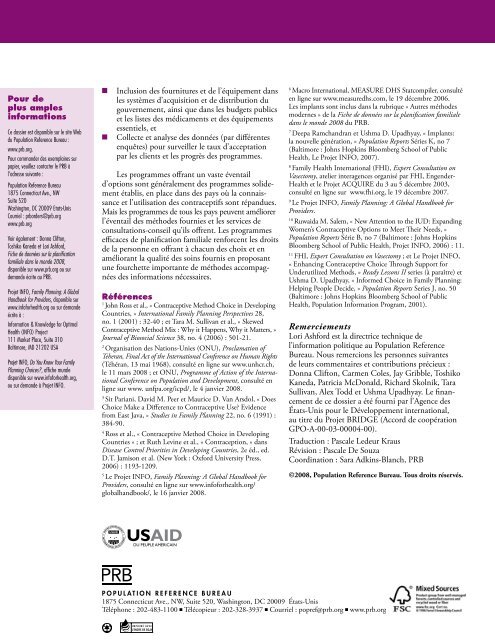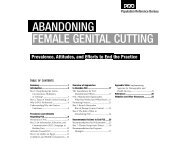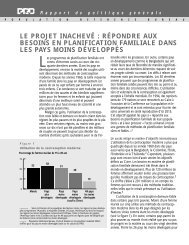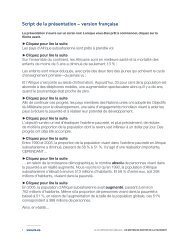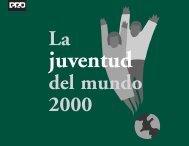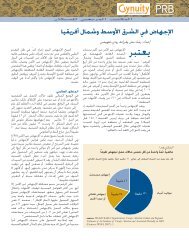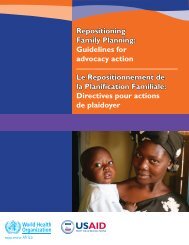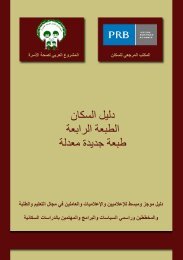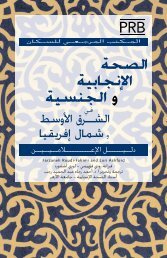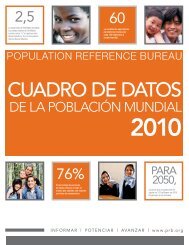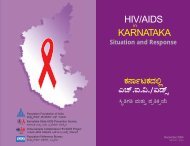Comment assurer un éventail d'options de planifiCation familiale
Comment assurer un éventail d'options de planifiCation familiale
Comment assurer un éventail d'options de planifiCation familiale
You also want an ePaper? Increase the reach of your titles
YUMPU automatically turns print PDFs into web optimized ePapers that Google loves.
TM<br />
Pour <strong>de</strong><br />
plus amples<br />
informations<br />
Ce dossier est disponible sur le site Web<br />
du Population Reference Bureau :<br />
www.prb.org.<br />
Pour comman<strong>de</strong>r <strong>de</strong>s exemplaires sur<br />
papier, veuillez contacter le PRB à<br />
l’adresse suivante :<br />
Population Reference Bureau<br />
1875 Connecticut Ave., NW<br />
Suite 520<br />
Washington, DC 20009 Etats-Unis<br />
Courriel : prbor<strong>de</strong>rs@prb.org<br />
www.prb.org<br />
Voir également : Donna Clifton,<br />
Toshiko Kaneda et Lori Ashford,<br />
Fiche <strong>de</strong> données sur la planification<br />
<strong>familiale</strong> dans le mon<strong>de</strong> 2008,<br />
disponible sur www.prb.org ou sur<br />
<strong>de</strong>man<strong>de</strong> écrite au PRB.<br />
Projet INFO, Family Planning: A Global<br />
Handbook for Provi<strong>de</strong>rs, disponible sur<br />
www.infoforhealth.org ou sur <strong>de</strong>man<strong>de</strong><br />
écrite à :<br />
Information & Knowledge for Optimal<br />
Health (INFO) Project<br />
111 Market Place, Suite 310<br />
Baltimore, MD 21202 USA<br />
Projet INFO, Do You Know Your Family<br />
Planning Choices?, affiche murale<br />
disponible sur www.infoforhealth.org,<br />
ou sur <strong>de</strong>man<strong>de</strong> à Projet INFO.<br />
n<br />
n<br />
Inclusion <strong>de</strong>s fournitures et <strong>de</strong> l’équipement dans<br />
les systèmes d’acquisition et <strong>de</strong> distribution du<br />
gouvernement, ainsi que dans les budgets publics<br />
et les listes <strong>de</strong>s médicaments et <strong>de</strong>s équipements<br />
essentiels, et<br />
Collecte et analyse <strong>de</strong>s données (par différentes<br />
enquêtes) pour surveiller le taux d’acceptation<br />
par les clients et les progrès <strong>de</strong>s programmes.<br />
Les programmes offrant <strong>un</strong> vaste éventail<br />
d’options sont généralement <strong>de</strong>s programmes soli<strong>de</strong>ment<br />
établis, en place dans <strong>de</strong>s pays où la connaissance<br />
et l’utilisation <strong>de</strong>s contraceptifs sont répandues.<br />
Mais les programmes <strong>de</strong> tous les pays peuvent améliorer<br />
l’éventail <strong>de</strong>s métho<strong>de</strong>s fournies et les services <strong>de</strong><br />
consultations-conseil qu’ils offrent. Les programmes<br />
efficaces <strong>de</strong> planification <strong>familiale</strong> renforcent les droits<br />
<strong>de</strong> la personne en offrant à chac<strong>un</strong> <strong>de</strong>s choix et en<br />
améliorant la qualité <strong>de</strong>s soins fournis en proposant<br />
<strong>un</strong>e fourchette importante <strong>de</strong> métho<strong>de</strong>s accompagnées<br />
<strong>de</strong>s informations nécessaires.<br />
Références<br />
1<br />
John Ross et al., « Contraceptive Method Choice in Developing<br />
Co<strong>un</strong>tries, » International Family Planning Perspectives 28,<br />
no. 1 (2001) : 32-40 ; et Tara M. Sullivan et al., « Skewed<br />
Contraceptive Method Mix : Why it Happens, Why it Matters, »<br />
Journal of Biosocial Science 38, no. 4 (2006) : 501-21.<br />
2<br />
Organisation <strong>de</strong>s Nations-Unies (ONU), Proclamation of<br />
Teheran, Final Act of the International Conference on Human Rights<br />
(Téhéran, 13 mai 1968), consulté en ligne sur www.<strong>un</strong>hcr.ch,<br />
le 11 mars 2008 ; et ONU, Programme of Action of the International<br />
Conference on Population and Development, consulté en<br />
ligne sur www. <strong>un</strong>fpa.org/icpd/, le 4 janvier 2008.<br />
3<br />
Sit Pariani, David M. Peer et Maurice D. Van Arsdol, « Does<br />
Choice Make a Difference to Contraceptive Use? Evi<strong>de</strong>nce<br />
from East Java, » Studies in Family Planning 22, no. 6 (1991) :<br />
384-90.<br />
4<br />
Ross et al., « Contraceptive Method Choice in Developing<br />
Co<strong>un</strong>tries » ; et Ruth Levine et al., « Contraception, » dans<br />
Disease Control Priorities in Developing Co<strong>un</strong>tries, 2e éd., ed.<br />
D.T. Jamison et al. (New York : Oxford University Press,<br />
2006) : 1193-1209.<br />
5<br />
Le Projet INFO, Family Planning: A Global Handbook for<br />
Provi<strong>de</strong>rs, consulté en ligne sur www.infoforhealth.org/<br />
globalhandbook/, le 16 janvier 2008.<br />
6<br />
Macro International, MEASURE DHS Statcompiler, consulté<br />
en ligne sur www.measuredhs.com, le 19 décembre 2006.<br />
Les implants sont inclus dans la rubrique « Autres métho<strong>de</strong>s<br />
mo<strong>de</strong>rnes » <strong>de</strong> la Fiche <strong>de</strong> données sur la planification <strong>familiale</strong><br />
dans le mon<strong>de</strong> 2008 du PRB.<br />
7<br />
Deepa Ramchandran et Ushma D. Upadhyay, « Implants:<br />
la nouvelle génération, » Population Reports Séries K, no 7<br />
(Baltimore : Johns Hopkins Bloomberg School of Public<br />
Health, Le Projet INFO, 2007).<br />
8<br />
Family Health International (FHI), Expert Consultation on<br />
Vasectomy, atelier interagences organisé par FHI, Engen<strong>de</strong>r-<br />
Health et le Projet ACQUIRE du 3 au 5 décembre 2003,<br />
consulté en ligne sur www.fhi.org, le 19 décembre 2007.<br />
9<br />
Le Projet INFO, Family Planning: A Global Handbook for<br />
Provi<strong>de</strong>rs.<br />
10<br />
Ruwaida M. Salem, « New Attention to the IUD: Expanding<br />
Women’s Contraceptive Options to Meet Their Needs, »<br />
Population Reports Série B, no 7 (Baltimore : Johns Hopkins<br />
Bloomberg School of Public Health, Projet INFO, 2006) : 11.<br />
11<br />
FHI, Expert Consultation on Vasectomy ; et Le Projet INFO,<br />
« Enhancing Contraceptive Choice Through Support for<br />
Un<strong>de</strong>rutilized Methods, » Ready Lessons II series (à paraître) et<br />
Ushma D. Upadhyay, « Informed Choice in Family Planning:<br />
Helping People Deci<strong>de</strong>, » Population Reports Series J, no. 50<br />
(Baltimore : Johns Hopkins Bloomberg School of Public<br />
Health, Population Information Program, 2001).<br />
Remerciements<br />
Lori Ashford est la directrice technique <strong>de</strong><br />
l’information politique au Population Reference<br />
Bureau. Nous remercions les personnes suivantes<br />
<strong>de</strong> leurs commentaires et contributions précieux :<br />
Donna Clifton, Carmen Coles, Jay Gribble, Toshiko<br />
Kaneda, Patricia McDonald, Richard Skolnik, Tara<br />
Sullivan, Alex Todd et Ushma Upadhyay. Le financement<br />
<strong>de</strong> ce dossier a été fourni par l’Agence <strong>de</strong>s<br />
États-Unis pour le Développement international,<br />
au titre du Projet BRIDGE (Accord <strong>de</strong> coopération<br />
GPO-A-00-03-00004-00).<br />
Traduction : Pascale Le<strong>de</strong>ur Kraus<br />
Révision : Pascale De Souza<br />
Coordination : Sara Adkins-Blanch, PRB<br />
©2008, Population Reference Bureau. Tous droits réservés.<br />
POPULATION REFERENCE BUREAU<br />
1875 Connecticut Ave., NW, Suite 520, Washington, DC 20009 États-Unis<br />
Téléphone : 202-483-1100 n Télécopieur : 202-328-3937 n Courriel : popref@prb.org n www.prb.org<br />
IMPRIMÉ AVEC<br />
L’ENCRE DE SOJA


